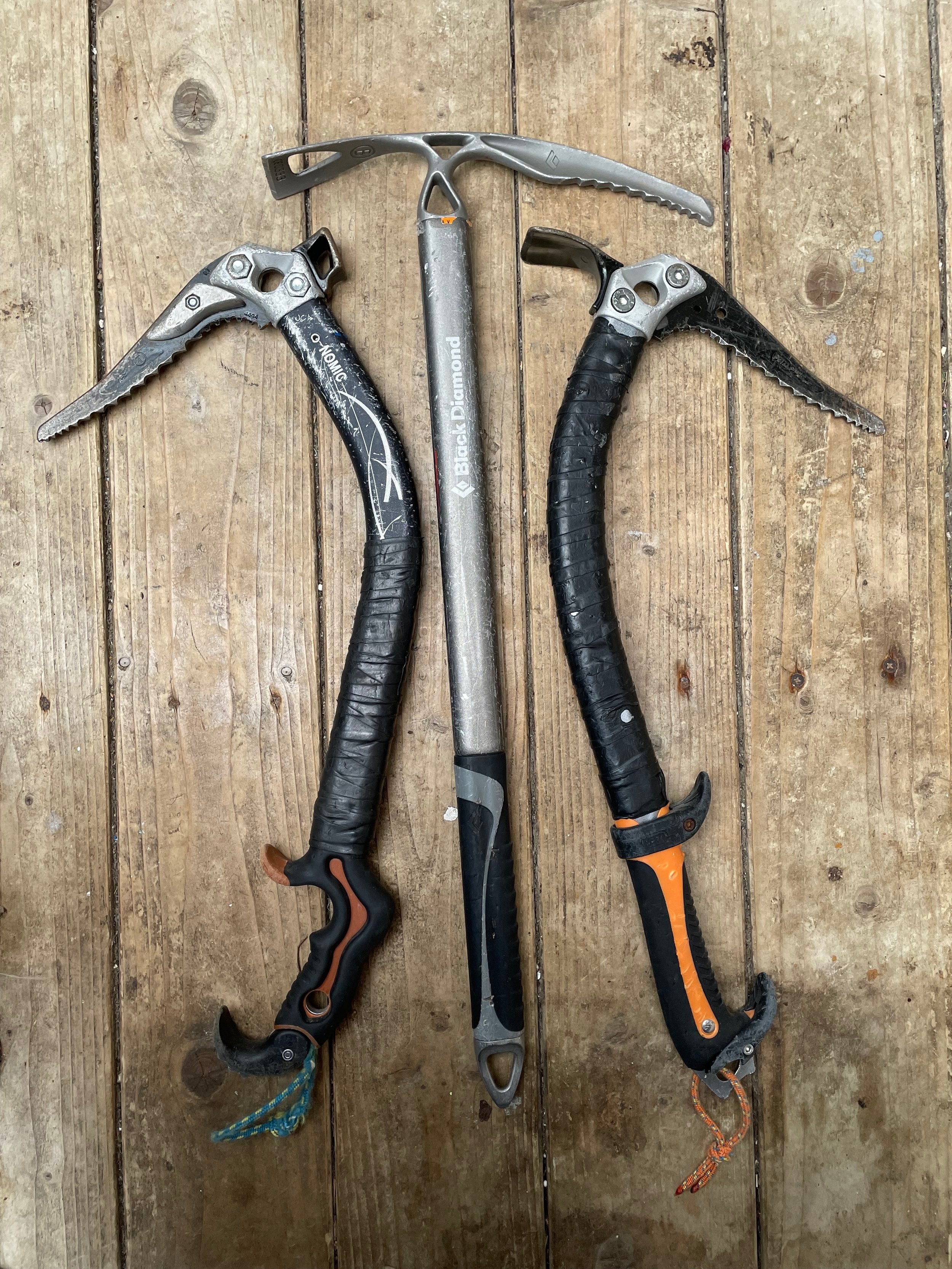There are a huge number of different ice axes out there to choose from, so what makes them different from each other, and which one is a good choice for your intended activity?
Firstly, it's good to understand the parts of the axe and their different shapes.
The straighter the shaft of the ice axe the more useful it is for walking and snow belays. The greater a curve the shaft has, the less tiring it is to climb steep rock or ice. The downside of radically curved tools is that digging in the snow and building ice axe belays is harder and more complicated.
Black Diamond Raven
Black Diamond Fuel
Petzl QUARK
Adze – This is used for chopping away at snow and ice, for cutting steps, digging to build snow anchors or clearing cracks when looking for rock climbing gear. The shape of the adze means it can be held onto when attempting ice axe arrests. It can be torqued in a crack and makes the head of the axe wide for climbing wide cracks.
Hammer – The hammer is used to placing and removing climbing gear and often for testing the stability of rock when building a belay.
Head – The top of the axe where the shaft joins the body which is often held when walking ready for use or self arrest.
Pick – The part which goes into the snow, ice or a crack in the rock. Walking and mountaineering axes have a curved pick which allows easy holding of the tool, daggering in the snow and use for self arrest in the event of a fall. Climbing axes feature a reverse curve for better ergonomics when climbing steep terrain, hooking onto rock and swinging into ice.
Shaft – Walking and mountaineering axes are usually straight or very slightly curved. This makes them good for plunging into snow and for use as a walking stick on steep ground. Technical climbing axes feature much more of a curved shaft which makes them better for climbing steep rock or ice but harder to plunge into the snow when walking or mountaineering.
Handle – All axes have some sort of handle for swinging the tool. Walking and mountaineering axes have minimal grips to make plunging the axe in the snow easy. Climbing axes have larger handle to facilitate easy gripping of the tool when mixed or ice climbing.
Spike – This is for grip when using the axe as a walking pole on icy or rocky terrain. Many modern tools also have a hole for attaching a leash to minimise risk of loosing an axe.
Modern axes are also classed as B or T (basic/technical). Both are strong enough for use as ice axe belays but T rated tools are designed to withstand the higher forces encountered from mixed climbing and drytooling such as torquing and stein-pulling.
So which axe to buy?
Having the right axe can make you life much easier. Plunging an Petzl NOMIC into snow when mountaineering is awkward because the large handle stops the axe penetrating. Climbing steep ice with a straight shafted tool is impossible as your hands slip down the shaft (ooo errr...)! I see three main groups which modern tools fall into:
General Walking and Mountaineering Axes: Axes with straight or slightly curved shafts: eg Black Diamond Raven, DMM Cirque/Raptor, Grivel Helix/Nepal.
Buy one of these if you are only going to be Scottish winter walking, climbing Ben Nevis in winter, scrambling grade 1 or 2 winter routes, climbing moderate snow gulleys or classic one axe alpinism around the world.
Look for an axe which is long enough to reach the top of your boot when held in your hand with a straight arm. Longer axes are easier to plunge in the snow and walk with but harder to use if you are using them above your head for traction.
Avoid buying an ultra light weight tool such as the Petzl RIDE for general use. These lightweight axes for use ski touring or at high altitude are great for saving weight but they are less effective because of this. The weight of a walking axe will actually help you penetrate the snow or cut ice efficiently.
‘All around’ tools with a medium curve: Axes with a curved shaft but lacking a large offset handle. These vary from the fairly straight eg. Petzl SUM’TEC or Black Diamond Venom to the more curved (but not radically so) eg. Petzl QUARK, Black Diamond Viper and DMM Fly.
Buy these if you can only afford a single pair of axes which have to do everything!
This style of tool is versatile enough that it can be plunged into snow and used as a walking axe but they have enough of a handle and a reverse curved pick to allow them to climb moderate winter routes when used as a pair.
If you imagine mostly doing moderate mountaineering routes then something like a pair of SUM’TEC or Vipers would be perfect. If you aspire to slightly more technical routes then it might be worth looking at a pair of QUARKS or similar.
Axes like this usually have removable adze and hammers as well as replaceable picks so they can be customised to your exact use. If you can only afford a single pair of axes which will do everything reasonably well then this style is the one to go for. A single tool with the adze will work as a mountaineering tool and the pair of QUARKS will happily allow you to climb grade V.
Modern climbing tools: these have a pronounced curved shaft and a large offset handle eg. Petzl NOMIC, Black Diamond Fuel, DMM Apex.
These are designed for hard winter or ice climbing. Large handles make them easy to hold onto, and the large curve of the shaft makes steep climbing easier. These tools often lack an adze or hammer which can make cutting snow anchors or hammering pitons into rock hard.
If you are climbing grade V and above then a pair of curved tools will make harder climbing feel less tiring. A pair of climbing tools like this will be perfect for climbing hard (V and above) routes in Scotland. It's worth remembering that they are difficult to dig snow anchors with and require doubling up in T-axe belays because of their radical shape. Because of this, I wouldn't take a super curved tool on a route where I expected to need to dig snow anchors.
Most people who own a pair of curved climbing tools like the NOMIC will also probably own a third mountaineering tool for use when winter walking or scrambling as these curved tools are not really suitable to moderate difficulty mountaineering outings.
For use mixed climbing and in Scotland I would also avoid the carbon fibre offerings from Grivel etc because they aren't robust enough for many seasons use – great if you are a professional athlete who gets a new pair every year, but less so for the rest of us! I would also avoid the radically curved tools designed for drytooling such as the Petzl ERGO.
A NOMIC, Raven and QUARK compared.
Want To See More?
Head over to Instagram and follow me @straightupadventures for more tips and tricks.
Not Sure What You're Doing?
Feel like you need some help with your climbing? Why not book onto a winter skills or climbing course and get some professional input, learn some new tricks and take your ropework to the next level.






